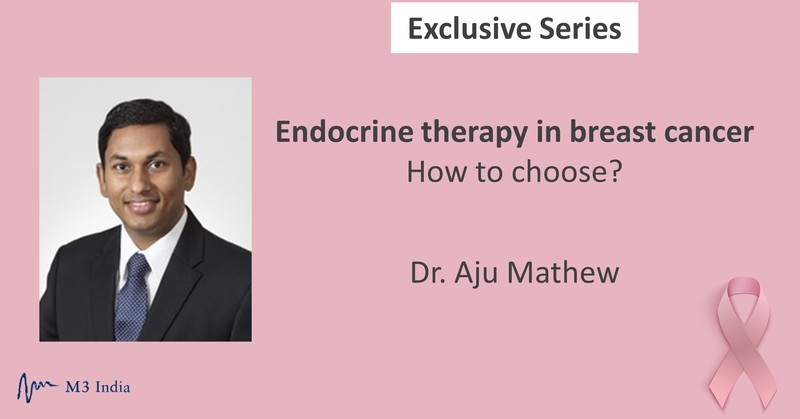Endocrine therapy in breast cancer- How to choose: Dr. Aju Mathew
M3 India Newsdesk Jun 15, 2020
Breast cancer care demands the best of both the art of medical practice and the science behind the recommendations. Here, Dr. Aju Mathew discusses practical considerations in endocrine therapy for early-stage and locally advanced breast cancer. He aims to highlight the nuances in the systemic therapy delivered with a curative-intent.
For our comprehensive coverage and latest updates on COVID-19 click here.

Endocrine therapy in premenopausal women: What’s new?
In just a few years, hormone-based therapy in non-metastatic breast cancer has undergone a sea change. If in 2015, the only treatment option for adjuvant systemic therapy in premenopausal women with breast cancer was Tamoxifen for five years, now, there are a handful of options. These are:
- Tamoxifen for 5-10 years
- Tamoxifen followed by aromatase inhibitors (Letrozole, Anastrozole, or Exemestane), when menopause is attained
- Tamoxifen plus Ovarian Function Suppression (OFS)
- Aromatase inhibitors plus Ovarian Function Suppression (OFS)
All the above options are backed up by level 1 evidence. Nevertheless, these additional options have increased chance of achieving a cure.
The evidence
The aTTOM and the ATLAS trial explored the impact of continuing Tamoxifen for up to 10 years instead of 5 years. [1,2] There was a significant reduction in breast cancer-related mortality of nearly 3% after 5 years of stopping the 10-year treatment course. Regardless of clinicopathological factors, all subgroups gained from extending Tamoxifen.
In the MA17 trial, patients who attained menopause were transitioned to aromatase inhibitors. [3] The study found that patients benefited from the treatment switch when compared to just continuing Tamoxifen.
The Suppression of Ovarian Function Trial (SOFT) randomised premenopausal women with early-stage breast cancer to receive Tamoxifen for 5 years, Tamoxifen plus OFS or Exemestane plus OFS. The Tamoxifen and Exemestane Trial (TEXT) had two arms (Tamoxifen plus OFS and Exemestane plus OFS). [4,5] Patients who had a higher risk disease, such as those who received adjuvant chemotherapy or were younger, gained significantly in terms of disease-free survival (DFS) from the addition of OFS to either Tamoxifen or aromatase inhibitors; comparable to that seen with the use of polychemotherapy in breast cancer. Impact on DFS was greater when aromatase inhibitors were used.
The trade-off: Toxicities
Extending Tamoxifen to more than 5 years added little in terms of toxicity, unless the patient became postmenopausal. There was an increased relative risk for incidence of pulmonary embolism and endometrial cancer. But keep in mind that 90% of patients in the ATLAS trial were postmenopausal at the start of trial.
We know that the use of Tamoxifen in postmenopausal women is strongly associated with an increased risk for endometrial cancer. The use of aromatase inhibitors is associated with sexual side-effects like vaginal dryness and dyspareunia, osteoporosis, hot flushes and metabolic syndrome. The addition of OFS to either Tamoxifen or aromatase inhibitors profoundly raise the risk for these side effects.
How to choose wisely?
Since the benefit of stronger hormonal therapy using OFS and toxicities are seen regardless of clinicopathological factors such as age, grade, tumour size, nodal status, we must be judicious in our recommendations. It is in this context that one should understand the relevance of quantifying benefit in absolute terms than relative. As intuitive as it sounds, I chose the strongest hormonal therapy for those who are at higher risk for distant recurrence. I am less concerned for an in-breast local recurrence.
Patients who have a higher-stage disease (especially nodal status) are at a higher risk for distant recurrence. Therefore, they would gain the most from a stronger endocrine blockade. I usually stick to Tamoxifen-only for my patients with low risk breast cancer. At the most, I may consider extending the duration of tamoxifen beyond five years for some of these women, if they are tolerating the therapy well at the five-year mark and are still premenopausal. When patients have attained menopause, I cautiously transition them to an aromatase inhibitor after ensuring that the baseline bone density scan shows normal bone mineral density.
For those patients who are at a higher risk for distant disease recurrence, I discuss the benefit and adverse effects of adding OFS. Those who are at a particularly higher risk for recurrence, I plan to initiate aromatase inhibitor therapy along with OFS.
Crossing a great barrier: Physician perception
All the above strategies have been proven to improve cure rates. Yet, some patients may not receive a recommendation for such treatment options. My mentees and I surveyed a group of oncologists practicing in the United States. [6] We provided them a clinical vignette of a woman with premenopausal breast cancer and a high risk for distant recurrence. We assessed their estimation of magnitude of benefit from adding OFS to Tamoxifen or aromatase inhibitors. Interestingly, regardless of age of the doctor, or their experience taking care of women with breast cancer, or their practice setting (academic vs private practice), doctors underestimated the benefit of endocrine therapy.
Unless we perceive the benefit precisely, we will not recommend appropriate treatment options to patients who deserve the best care. For that, we must cross the great barrier which is the mind of the oncologist. We must better appreciate the power of hormone-based therapy in adjuvant systemic therapy of non-metastatic breast cancer.
Click here to see references
Disclaimer- The views and opinions expressed in this article are those of the author's and do not necessarily reflect the official policy or position of M3 India.
The author, Dr. Aju Mathew is a Senior Consultant Medical Oncologist at Kochi.
-
Exclusive Write-ups & Webinars by KOLs
-
Daily Quiz by specialty
-
Paid Market Research Surveys
-
Case discussions, News & Journals' summaries